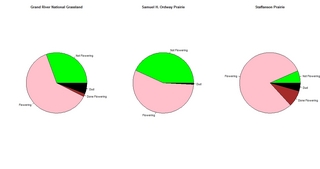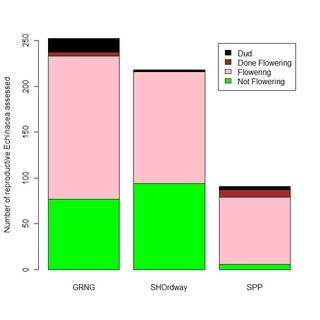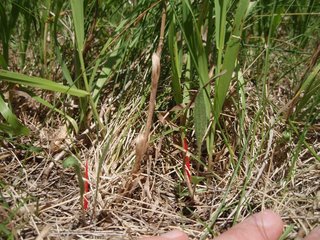This graph summarizes the First and Last Day of Flowering for Echinacea plants in the common garden. It looks like peak flowering was July 8, 2010.
|
||||
|
I analyzed my data and put together a couple of tables and figures. one thing that is interesting to me is that each species of bee was more sucessful in pollinating styles that had been 2 days old rather than 1 day old styles. hmmm? Maybe styles that are out for more than a day are more susceptable to shriveling..? Also, when Gretel compiles the data for CG phenology into a figure, I will use the figure to match up dates for when I did the insect visits and which species I saw most on those days. It should be interesting because it seems to be that in the beginning of flowering and towards the end of flowering, the smaller bees such as Augochlorella appear. Whereas during the peak of flowering, Melissodes dominated and I didn’t see any Augochlorella. -Katie I have some pictures of pollinators, but more to choose from would always be helpful for putting together my poster in a couple weeks. If so.. I would like any good pictures of Melissodes, Agopostemon, Augochlorella, Ceratina, and Lasioglossum. Preferably on Echinacea. If you could go through them and put them on a USB for me, that would be greatly appreciated. And I would acknowledge you for the picture if I use one of yours. Thanks, Katie Last week I assessed Echinacea flowering phenology at Grand River National Grassland south of Lemmon, SD, Samuel H. Ordway Prairie west of Leola, SD and Staffanson Prairie near Kensington, MN. Here are a couple of figures I generated to compare phenology at the 3 sites. Next, to show more quantitative information, I used a stacked bar graph. These figures illustrate that the flowering phenology is most advanced at Staffanson and least advanced at S. H. Ordway Prairie. Nevertheless, I am encouraged that there are lots of flowering plants at all 3 sites, suggesting that a long-distance cross involving plants from these 3 locations would be possible. I am considering tackling that project next summer, to assess whether there would be lower seedling recruitment from between-population crosses compared to within-population crosses at these 3 sites. Here’s a picture of some flowering Echinacea at Perch Lake, which is near the S. H. Ordway prairie. Here is a picture of 2 of the 3 surviving plants in my experimental plot at Perch Lake Waterfowl Production Area, southwest of Leola, SD. The Perch Lake site is 1 of 3 experimental plots I (and my assistants) sowed in November 2008, to ask whether Echinacea from western South Dakota, central South Dakota and Minnesota exhibit local adaptation in seedling recruitment. More background and results from the 1st 2009 census are displayed in a poster that you can find in the September 2009 archives of the FLOG. Unfortunately, the Perch Lake site was sprayed with a combination of herbicides (Tordon and Telar) in August 2009. The treatment was lethal to ALL the Echinacea seedlings that emerged in 2009. Thus, the 3 surviving seedlings from this year are the only living Echinacea in this plot! Fortunately, I was able to census the plot shortly after it was sprayed, and I am confident that I found the survivors up to that point. I plan to present a talk about my local adaptation experiment at the North American Prairie conference in August. Today we will start measuring Echinacea in the Common Garden. Here is the link to the protocol: CGmeasureprotocol2010.htm Four plants are flowering in Andrea’s garden this year. Andrea Southgate planted this experiment (aka inb2) in 2006 as part of her Master’s research project. Andrea and Jennifer made a photo essay about their plantings that year. These are the first plants to flower in this experiment–about 4/1500 in their fifth growing season! Today Josh and I searched the last two circles at Staffanson Prairie (SPP). Our last search centered on this focal plant: So this past week I was able to work on my project because the Echinacea has started flowering in the common garden! So far so good, but it is going slow… The painting is going really well. I am able to distinguish one and two day old styles wonderfully based on how I am painting the brachts. However, the pollinators take their sweet time to visit my flowering Echinacea head when I want to do the single insect visit. I was under the silly impression that I would remove the pollinator exclusion bag and a bee would come flying to the flower, do its pollinating thing, and let me move on to the next plant. Wrong! Sometimes it takes a bee 30min to and hour to land on the flowering head, which means I am sitting there patiently watching a single Echinacea head for a long time. UffDa! I do video tape the bees in case one lands that I cannot identify in the field. Plus, it’s nice to have video for my presentation later. BUT the video camera’s battery dies after a couple hours. So we may have to purchase a back up battery… I have had 8 insect visits this week so far, and have noticed that they have all been after 10am. Maybe 10 – noon is the peek time for bees to collect pollen? Not sure yet. The interesting thing is: when observing the shriveling or lack of the day after, Melissodes shriveled 1 style and only had a 3 second long visit! Both Augochlorella’s shriveled 1-2 styles each and they spent 5-7 min each on the Echinacea head! Looks like they are not very efficient pollinators, most likely do to thier small size and they barely touch the styles when collecting pollen from the anthers. Same with the Lasioglossum, which is around the same size as Augochlorella and it didn’t shrivel any styles. The Agopostemon spent a few minutes gathering pollen and shriveled 5 styles! I am curious to assess the shriveling of the other Agopostemon and the Ceratina (another small sized bee) tomorrow because those were the visits I had today. A concern of mine is all the bags that are on the flowering heads in the common garden. Several people, including myself, are using pollinator exclusion bags. So maybe if the bees know that they wont be able to collect pollen as readily from the common garden, maybe they do not bother visiting as much as they would if the bags were not on the heads. Any thoughts? Also Gretel- would you be able to provide me with the peak flowering data from within the common garden when the time is right so that I can compare that to a peak in pollinator efficiency (if I see one)? I believe thats all for now! I look forward to giving another update on pollinators next week! 🙂 Later, |
||||
|
© 2024 The Echinacea Project - All Rights Reserved - Log in Powered by WordPress & Atahualpa |
||||

-thumb-320x242-50642.jpg)




